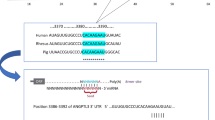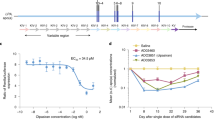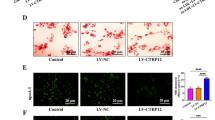Abstract
Cardiovascular disease remains the leading cause of mortality in westernized countries, despite optimum medical therapy to reduce the levels of low-density lipoprotein (LDL)-associated cholesterol. The pursuit of novel therapies to target the residual risk has focused on raising the levels of high-density lipoprotein (HDL)-associated cholesterol in order to exploit its atheroprotective effects1. MicroRNAs (miRNAs) have emerged as important post-transcriptional regulators of lipid metabolism and are thus a new class of target for therapeutic intervention2. MicroRNA-33a and microRNA-33b (miR-33a/b) are intronic miRNAs whose encoding regions are embedded in the sterol-response-element-binding protein genes SREBF2 and SREBF1 (refs 3–5), respectively. These miRNAs repress expression of the cholesterol transporter ABCA1, which is a key regulator of HDL biogenesis. Recent studies in mice suggest that antagonizing miR-33a may be an effective strategy for raising plasma HDL levels3,4,5 and providing protection against atherosclerosis6; however, extrapolating these findings to humans is complicated by the fact that mice lack miR-33b, which is present only in the SREBF1 gene of medium and large mammals. Here we show in African green monkeys that systemic delivery of an anti-miRNA oligonucleotide that targets both miR-33a and miR-33b increased hepatic expression of ABCA1 and induced a sustained increase in plasma HDL levels over 12 weeks. Notably, miR-33 antagonism in this non-human primate model also increased the expression of miR-33 target genes involved in fatty acid oxidation (CROT, CPT1A, HADHB and PRKAA1) and reduced the expression of genes involved in fatty acid synthesis (SREBF1, FASN, ACLY and ACACA), resulting in a marked suppression of the plasma levels of very-low-density lipoprotein (VLDL)-associated triglycerides, a finding that has not previously been observed in mice. These data establish, in a model that is highly relevant to humans, that pharmacological inhibition of miR-33a and miR-33b is a promising therapeutic strategy to raise plasma HDL and lower VLDL triglyceride levels for the treatment of dyslipidaemias that increase cardiovascular disease risk.
This is a preview of subscription content, access via your institution
Access options
Subscribe to this journal
Receive 51 print issues and online access
$199.00 per year
only $3.90 per issue
Buy this article
- Purchase on Springer Link
- Instant access to full article PDF
Prices may be subject to local taxes which are calculated during checkout




Similar content being viewed by others
Accession codes
Data deposits
The microarray data have been deposited in the Gene Expression Omnibus database under accession number GSE31177.
References
deGoma, E. M. & Rader, D. J. Novel HDL-directed pharmacotherapeutic strategies. Nature Rev. Cardiol. 8, 266–277 (2011)
Moore, K. J., Rayner, K. J., Suarez, Y. & Fernandez-Hernando, C. MicroRNAs and cholesterol metabolism. Trends Endocrinol. Metab. 21, 699–706 (2010)
Marquart, T. J., Allen, R. M., Ory, D. S. & Baldan, A. miR-33 links SREBP-2 induction to repression of sterol transporters. Proc. Natl Acad. Sci. USA 107, 12228–12232 (2010)
Najafi-Shoushtari, S. H. et al. MicroRNA-33 and the SREBP host genes cooperate to control cholesterol homeostasis. Science 328, 1566–1569 (2010)
Rayner, K. J. et al. miR-33 contributes to the regulation of cholesterol homeostasis. Science 328, 1570–1573 (2010)
Rayner, K. J. et al. Antagonism of miR-33 in mice promotes reverse cholesterol transport and regression of atherosclerosis. J. Clin. Invest. 121, 2921–2931 (2011)
Davalos, A. et al. miR-33a/b contribute to the regulation of fatty acid metabolism and insulin signaling. Proc. Natl Acad. Sci. USA 108, 9232–9237 (2011)
Gerin, I. et al. Expression of miR-33 from an SREBP2 intron inhibits cholesterol export and fatty acid oxidation. J. Biol. Chem. 285, 33652–33661 (2010)
Horton, J. D., Goldstein, J. L. & Brown, M. S. SREBPs: activators of the complete program of cholesterol and fatty acid synthesis in the liver. J. Clin. Invest. 109, 1125–1131 (2002)
Horie, T. et al. microRNA-33 encoded by an intron of sterol regulatory element-binding protein 2 (Srebp2) regulates HDL in vivo . Proc. Natl Acad. Sci. USA 107, 17321–17326 (2010)
Geary, R. S. Antisense oligonucleotide pharmacokinetics and metabolism. Expert Opin. Drug Metab. Toxicol. 5, 381–391 (2009)
Chyu, K. Y., Peter, A. & Shah, P. K. Progress in HDL-based therapies for atherosclerosis. Curr. Atheroscler. Rep. 3, 405–412 (2011)
Alberti, K. G. et al. Harmonizing the metabolic syndrome: a joint interim statement of the International Diabetes Federation Task Force on Epidemiology and Prevention; National Heart, Lung, and Blood Institute; American Heart Association; World Heart Federation; International Atherosclerosis Society; and International Association for the Study of Obesity. Circulation 120, 1640–1645 (2009)
Wagner, J. E. et al. Old world nonhuman primate models of type 2 diabetes mellitus. ILAR J. 47, 259–271 (2006)
Fitzgerald, M. L. et al. ATP-binding cassette transporter A1 contains an NH2-terminal signal anchor sequence that translocates the protein’s first hydrophilic domain to the exoplasmic space. J. Biol. Chem. 276, 15137–15145 (2001)
Yvan-Charvet, L. et al. ATP-binding cassette transporters and HDL suppress hematopoietic stem cell proliferation. Science 328, 1689–1693 (2010)
Kieft, K. A., Bocan, T. M. A. & Krause, B. R. Rapid on-line determination of cholesterol distribution among plasma lipoproteins after high-performance gel filtration chromatography. J. Lipid Res. 32, 859–866 (1991)
Garber, D. W., Kulkarni, K. R. & Anantharamaiah, G. M. A sensitive and convenient method for lipoprotein profile analysis of individual mouse plasma samples. J. Lipid Res. 41, 1020–1026 (2000)
Jeyarajah, E. J., Cromwell, W. C. & Otvos, J. D. Lipoprotein particle analysis by nuclear magnetic resonance spectroscopy. Clin. Lab. Med. 26, 847–870 (2006)
Koritnik, D. L. & Rudel, L. L. Measurement of apolipoprotein A-I concentration in nonhuman primate serum by enzyme-linked immunosorbent assay (ELISA). J. Lipid Res. 24, 1639–1645 (1983)
Acknowledgements
This work was supported by grants from the National Institutes of Health to K.J.M. (R01AG02055 and R01HL108182), E.A.F. (P01HL098055, R01HL084312 and R01HL58541), C.F.-H. (1P30HL101270 and R01HL107953), R.E.T. (R00HL088528), as well as by the Canadian Institutes of Health Research (K.J.R.)
Author information
Authors and Affiliations
Contributions
K.J.M. and R.E.T. contributed equally to this study. K.J.M., R.E.T., C.C.E. and K.J.R. designed the study. C.J.L., R.E.T., A.L.M., S.M.M. and K.J.R. assisted in the necropsy. K.J.R., R.E.T., F.N.H., J.M.V.G., F.J.S., L.G. and T.D.R. performed the biological assays. C.C.E., X.L., O.G.K. and V.K. conducted the miRNA and microarray analyses. E.A.F. and C.F.-H. assisted with the experimental design and data interpretation. K.J.M. and K.J.R. wrote the first draft of the manuscript, which was commented on by all authors.
Corresponding authors
Ethics declarations
Competing interests
E.A.F. is a Merck Advisory board member and receives honoraria for speaking engagements. C.C.E., X.L., O.G.K., V.K. are employees of Regulus Therapeutics. K.J.R., C.F-H. and K.J.M. have a pending patent on the use of miR-33 inhibitors.
Supplementary information
Supplementary Information
This file contains Supplementary Tables 1-3 and Supplementary Figures 1-4 with legends. (PDF 1306 kb)
Rights and permissions
About this article
Cite this article
Rayner, K., Esau, C., Hussain, F. et al. Inhibition of miR-33a/b in non-human primates raises plasma HDL and lowers VLDL triglycerides. Nature 478, 404–407 (2011). https://doi.org/10.1038/nature10486
Received:
Accepted:
Published:
Issue Date:
DOI: https://doi.org/10.1038/nature10486
This article is cited by
-
Temporal associations between leukocytes DNA methylation and blood lipids: a longitudinal study
Clinical Epigenetics (2022)
-
Epigenetic regulation in cardiovascular disease: mechanisms and advances in clinical trials
Signal Transduction and Targeted Therapy (2022)
-
New insights into macrophage subsets in atherosclerosis
Journal of Molecular Medicine (2022)
-
Association of MIR17HG and MIR155HG gene variants with steroid-induced osteonecrosis of the femoral head in the population of northern China
Journal of Orthopaedic Surgery and Research (2021)
-
Sulforaphane downregulated fatty acid synthase and inhibited microtubule-mediated mitophagy leading to apoptosis
Cell Death & Disease (2021)
Comments
By submitting a comment you agree to abide by our Terms and Community Guidelines. If you find something abusive or that does not comply with our terms or guidelines please flag it as inappropriate.



